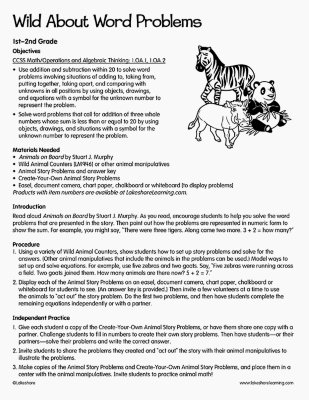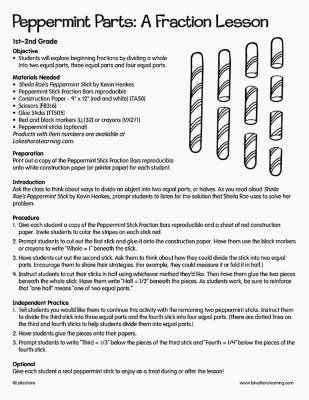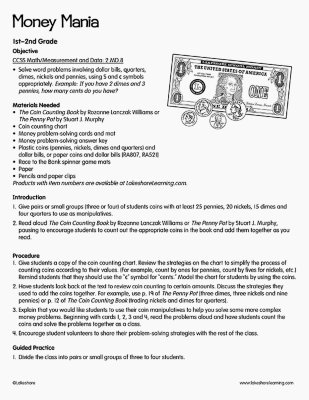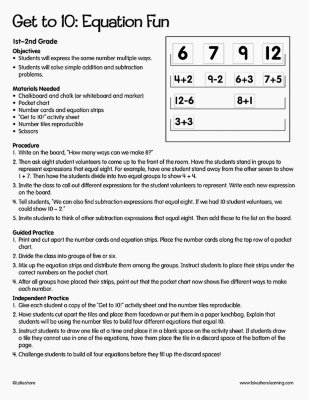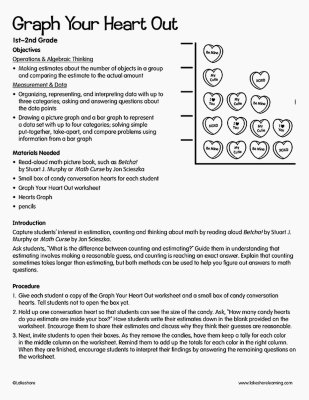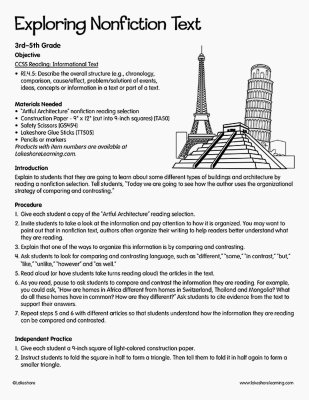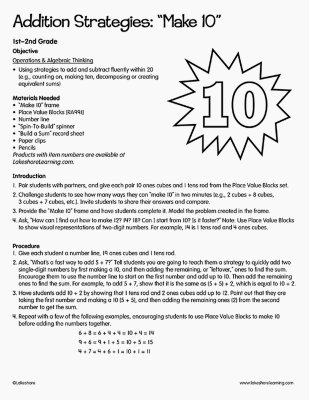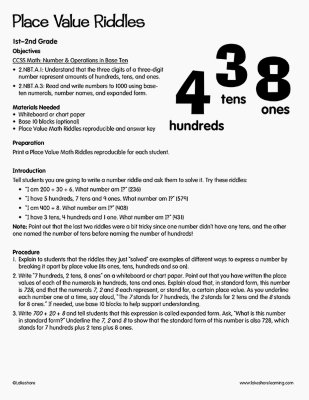Narrow by Grade
- Infant (1)
- Toddler (2)
- Preschool (0)
- Pre-K (7)
- Kindergarten (3)
- 1st (8)
- 2nd (9)
- 3rd (8)
- 4th (6)
- 5th (6)
- 6th & Up (0)
Grade 2nd
Narrow by Age
- 0-18m (0)
- 18-36m (0)
- 3 yrs. (0)
- 4 yrs. (0)
- 5 yrs. (0)
- 6 yrs. (5)
- 7 yrs. (9)
- 8 yrs. (0)
- 9 yrs. (0)
- 10 yrs. (0)
- 11 yrs. & Up (0)
Age
9 results for "problem solving stem kits"
Filters
Clear All
Wild About Word Problems
1st Grade - 2nd Grade
Objectives CCSS Math/Operations and Algebraic Thinking: 1.OA.1, 1.OA.2 Use addition and subtraction within 20 to solve word problems involving situations of adding to, taking from, putting together, taking apart, and comparing with unknowns in all positions by using objects, drawings, and equations with a symbol for the unknown number to represent the problem. Solve word problems that call for addition of three whole numbers whose sum is less than or equal to 20 by using objects, drawings, and situations with a symbol for the unknown number to represent the problem. Materials Needed Animals on Board by Stuart J. Murphy Wild Animal Counters or other animal manipulatives Animal Story Problems and answer key Create-Your-Own Animal Story Problems Easel, document camera, chart paper, chalkboard or whiteboard [to display problems] Introduction Read aloud Animals on Board by Stuart J. Murphy. As you read, encourage students to help you solve the word problems that are presented in the story. Then point out how the problems are represented in numeric form to show the sum. For example, you might say, “There were three tigers. Along came two more. 3 + 2 = how many?”
View Lesson PlanMystery Coins
1st Grade - 2nd Grade
Objectives Number & Operations in Base Ten Understanding 10 as a bundle of ten ones Skip-counting by 5s, 10s, and 100s Measurement & Data Solving word problems involving dollar bills, quarters, dimes, nickels, and pennies, using $ and ¢ symbols Materials Needed Plastic coins (or paper coins reproducible and scissors) Coin Values reproducible Mystery Coins reproducible Chart paper Marker Introduction Hold up each coin and review its name and value. You may want to print out and display the Coin Values reproducible for students to use as a reference. Be sure to show students both sides of each coin, and remind them that larger coins do not necessarily have greater values.
View Lesson PlanPeppermint Parts: A Fraction Lesson
2nd Grade
Objective Students will explore beginning fractions by dividing a whole into two equal parts, three equal parts and four equal parts. Materials Needed Sheila Rae’s Peppermint Stick by Kevin Henkes Peppermint Stick Fraction Bars reproducible Construction Paper - 9" x 12" (red and white) Scissors Glue Sticks Red and black markers or crayons Peppermint sticks (optional) Preparation: Print out a copy of the Peppermint Stick Fraction Bars reproducible onto white construction paper (or printer paper) for each student. Introduction Ask the class to think about ways to divide an object into two equal parts, or halves. As you read aloud Sheila Rae’s Peppermint Stick by Kevin Henkes, prompt students to listen for the solution that Sheila Rae uses to solve her problem.
View Lesson PlanMoney Mania
2nd Grade
Objective CCSS Math/Measurement and Data: 2.MD.8 Solve word problems involving dollar bills, quarters, dimes, nickels and pennies, using $ and ¢ symbols appropriately. Example: If you have 2 dimes and 3 pennies, how many cents do you have? Materials Needed The Coin Counting Book by Rozanne Lanczak Williams or The Penny Pot by Stuart J. Murphy Coin counting chart Money problem-solving cards and mat Money problem-solving answer key Plastic coins (pennies, nickels, dimes and quarters) and dollar bills, or paper coins and dollar bills Race to the Bank spinner game mats Paper Pencils and paper clips Introduction Give pairs or small groups (three or four) of students coins with at least 25 pennies, 20 nickels, 15 dimes and four quarters to use as manipulatives. Read aloud The Coin Counting Book by Rozanne Lanczak Williams or The Penny Pot by Stuart J. Murphy, pausing to encourage students to count out the appropriate coins in the book and add them together as you read.
View Lesson PlanGet to 10: Equation Fun
2nd Grade
Objectives Students will express the same number multiple ways. Students will solve simple addition and subtraction problems. Materials Needed Chalkboard and chalk (or whiteboard and marker) Pocket chart Number cards and equation strips “Get to 10!” activity sheet Number tiles reproducible Scissors
View Lesson PlanGraph Your Heart Out
1st Grade - 2nd Grade
Objectives Operations & Algebraic Thinking Making estimates about the number of objects in a group and comparing the estimate to the actual amount Measurement & Data Organizing, representing, and interpreting data with up to three categories; asking and answering questions about the data points Drawing a picture graph and a bar graph to represent a data set with up to four categories; solving simple put-together, take-apart, and compare problems using information from a bar graph Materials Needed Read-aloud math picture book, such as Betcha! by Stuart J. Murphy or Math Curse by Jon Scieszka Small box of candy conversation hearts for each student Graph Your Heart Out worksheet Hearts Graph pencils Introduction Capture students’ interest in estimation, counting and thinking about math by reading aloud Betcha! by Stuart J. Murphy or Math Curse by Jon Scieszka. Ask students, “What is the difference between counting and estimating?” Guide them in understanding that estimating involves making a reasonable guess, and counting is reaching an exact answer. Explain that counting sometimes takes longer than estimating, but both methods can be used to help you figure out answers to math questions.
View Lesson PlanExploring Nonfiction Text
1st Grade - 2nd Grade
Objective CCSS Reading: Informational Text RI.4.5: Describe the overall structure (e.g., chronology, comparison, cause/effect, problem/solution) of events, ideas, concepts or information in a text or part of a text. Materials Needed “Artful Architecture” nonfiction reading selection Construction Paper - 9" x 12" (cut into 9-inch squares) Safety Scissors Lakeshore Glue Sticks Pencils or markers Introduction Explain to students that they are going to learn about some different types of buildings and architecture by reading a nonfiction selection. Tell students, “Today we are going to see how the author uses the organizational strategy of comparing and contrasting.”
View Lesson PlanAddition Strategies: "Make 10"
1st Grade - 2nd Grade
Objective Operations & Algebraic Thinking Using strategies to add and subtract fluently within 20 (e.g., counting on, making ten, decomposing or creating equivalent sums) Materials Needed “Make 10” frame Place Value Blocks Number line “Spin-To-Build” spinner “Build a Sum” record sheet Paper clips Pencils Introduction Pair students with partners, and give each pair 10 ones cubes and 1 tens rod from the Place Value Blocks set. Challenge students to see how many ways they can “make 10” in two minutes (e.g., 2 cubes + 8 cubes, 3 cubes + 7 cubes, etc.). Invite students to share their answers and compare. Provide the “Make 10” frame and have students complete it. Model the problem created in the frame. Ask, “How can I find out how to make 12? 14? 18? Can I start from 10? Is it faster?” Note: Use Place Value Blocks to show visual representations of two-digit numbers. For example, 14 is 1 tens rod and 4 ones cubes.
View Lesson PlanPlace Value Riddles
2nd Grade
Objectives CCSS Math: Number & Operations in Base Ten 2.NBT.A.1: Understand that the three digits of a three-digit number represent amounts of hundreds, tens, and ones. 2.NBT.A.3: Read and write numbers to 1000 using base-ten numerals, number names, and expanded form. Materials Needed Whiteboard or chart paper Base 10 blocks (optional) Place Value Math Riddles reproducible and answer key Introduction Tell students you are going to write a number riddle and ask them to solve it. Try these riddles: “I am 200 + 30 + 6. What number am I?” (236) “I have 5 hundreds, 7 tens and 9 ones. What number am I?” (579) “I am 400 + 8. What number am I?” (408) “I have 3 tens, 4 hundreds and 1 one. What number am I?” (431) Note: Point out that the last two riddles were a bit tricky since one number didn’t have any tens, and the other one named the number of tens before naming the number of hundreds!
View Lesson Plan